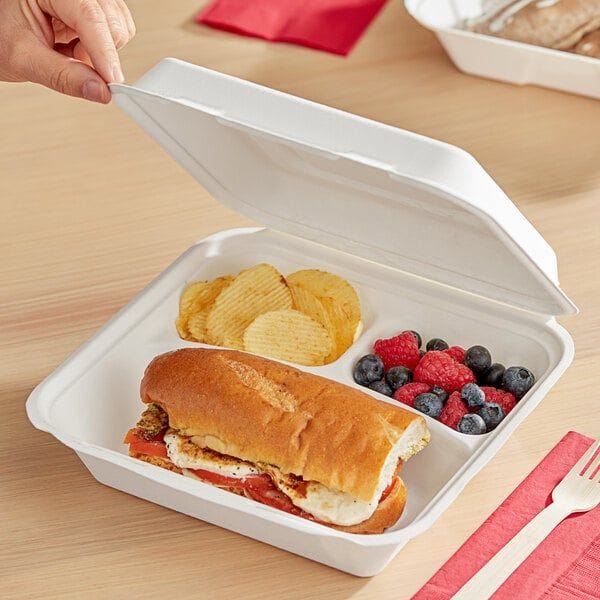Beyond Plastic: Why Bagasse Clamshell Boxes Are Leading the Compostable Packaging Revolution
How Bagasse Clamshell Boxes Are Redefining Takeout Packaging for a Greener Future
Intro
As single-use plastic bans expand globally and consumer demand for eco-conscious products continues to grow, one packaging solution is emerging as the frontrunner in the foodservice sector: the bagasse clamshell box. Made from the leftover pulp of sugarcane after juice extraction, this innovative product combines sustainability with functionality — offering an ideal alternative to traditional plastic takeout containers.
What Is a Bagasse Clamshell Box?
Bagasse clamshell boxes are molded fiber food containers made from sugarcane pulp, a renewable byproduct of sugar production. Their sturdy one-piece hinged design makes them especially popular for takeaway meals such as burgers, rice boxes, salads, or combination plates.
Unlike plastic or foam, these boxes are:
Fully compostable
Microwave and freezer safe
Grease- and cut-resistant
PFAS-free in certified versions
These qualities make them ideal for restaurants, food trucks, and catering services looking to reduce environmental impact without sacrificing performance.
Why Food Businesses Are Switching to Bagasse Containers
With environmental regulations tightening and customers demanding greener choices, brands across the food industry are rapidly shifting to compostable packaging options. Bagasse clamshells tick all the boxes:
✅ Reduce landfill waste and carbon footprint
✅ Signal eco-conscious brand values
✅ Align with Extended Producer Responsibility (EPR) regulations in the EU, Canada, and parts of the US
✅ Improve customer loyalty and social media perception
Restaurants using bagasse containers often report a boost in customer satisfaction, especially among millennials and Gen Z consumers who prefer sustainable dining options.
Performance Without Compromise
Bagasse clamshell boxes are often misunderstood as less durable than plastic — but that’s a myth.
Heat tolerance: Withstand high temperatures, suitable for hot foods and microwaving.
Moisture resistance: Ideal for sauces, fried food, or juicy meals.
Structural strength: Rigid enough to stack during deliveries or display on shelves.
They're now widely used not just for burgers and sandwiches, but also for full meal portions in Asian, Mediterranean, and vegan restaurants.
Comparing Bagasse with Other Sustainable Materials
MaterialCompostabilityGrease ResistanceCostCommon Use
Bagasse✔️ Commercial & Home✔️ StrongMediumHot foods, combo meals
PLA (bioplastic)✔️ Industrial onlyModerateMedium-HighCold drinks, lids
Kraft paper✔️ YesNeeds coatingLowDry foods
Bamboo✔️ Yes✔️ StrongHighPremium packaging
Bagasse strikes the right balance of performance, affordability, and sustainability — especially for high-volume takeout operations.
Regulatory Momentum Is on Your Side
Governments worldwide are enforcing bans or taxes on polystyrene, plastic foam, and even PET containers. For example:
EU Directive (EU 2019/904) mandates reductions in single-use plastics
California SB 54 requires 100% recyclable or compostable packaging by 2032
Canada’s Single-Use Plastics Prohibition Regulations are in effect since 2023
India banned disposable plastic food containers nationally in 2022
Switching to bagasse clamshells isn’t just good for the planet — it’s now a legal advantage.
Real-World Adoption — Case Snapshot
A mid-sized Mediterranean restaurant chain in Canada replaced all their plastic lunch boxes with 3-compartment bagasse clamshells in 2024. The result?
40% decrease in packaging-related complaints
62% waste reduction in back-of-house disposal
Featured in a “green eats” local blog — boosting foot traffic
Compliance with local composting requirements
Their takeaway line is now fully compliant, functional, and profitable.
Is Bagasse Right for Your Business?
If your food service model includes:
Takeaway and delivery
Hot and greasy items
Sustainability goals or ESG commitments
...then bagasse clamshell boxes are likely your best next step.
Whether you're running a burger joint, a bento box concept, or a vegan meal prep service, these containers offer a blend of eco-innovation and operational reliability.
Conclusion
As food packaging continues to evolve under both consumer and regulatory pressure, bagasse clamshell boxes stand out as the smart, scalable, and sustainable solution. They're not just a trend — they're a transition.
Restaurants, cafés, and delivery platforms embracing this material are positioning themselves at the forefront of the zero-waste movement while staying ahead of compliance curves.
Now is the time to make the switch — not just for your brand image, but for the future of food packaging.



